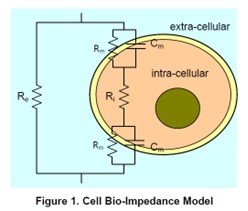Healthcare and fitness are increasingly important to many people. The ease of making measurements or showing improvement metrics and the amount of data that can be provided by a minimal, non-invasive process makes the ongoing effort sustainable. Bioelectrical impedance (or bioimpedance) analysis (BIA) provides users with a technique that is easily integrated into smart watches or bathroom scales. For example, in addition to the user’s weight, with additional user provided personal specifics, a bathroom scale with BIA capability can indicate body mass index (BMI), percent of body fat, fat-free body weight, subcutaneous fat, skeletal muscle, muscle mass, bone mass, skeletal muscle, basal metabolic rate (BRI) and even metabolic age.
To analyze human body composition, bioimpedance analysis uses a small alternating current applied through the skin to measure the impedance. Those readings are then translated using validated algorithms into estimations of various metrics. Key aspects of the sensing process are the measuring electrodes, the type of ac power provided (frequency or frequencies), the impedance measurement and the algorithms used for subsequent calculations.
While the roots of BIA go back to 1786 and experiments in frog’s skin tissue structure conducted by Luigi Galvani, it wasn’t until the 1960s that the current interest began. Methods to implement bio-impedance analysis (BIA) include single frequency BIA (SF-BIA), multi-frequency BIA (MF-BIA), segmental-BIA, and bioelectrical spectroscopy (BIS). To simplify the design of products to perform BIA, several companies developed a biosensing analog front end (AFE) for analog signal conditioning and A/D conversion, power management and voltage and current measurements. For example, Texas Instruments AFE4300 was the industry’s first fully integrated analog front end for both weight and body composition measurement (BCM).

The bio-impedance of a cell is decided by various factors including cell size, shape, density, homogeneity, and more. Image source: Texas Instruments.
Samsung designed its S3FBP5A Bio-Processor to integrate five AFEs including bioelectrical impedance analysis (BIA), photoplethysmogram (PPG), electrocardiogram (ECG), skin temperature, and galvanic skin response (GSR) into a single chip solution. The combined techniques measure body fat, and skeletal muscle mass, heart rate, heart rhythm, skin temperature and stress level, respectively.
References for further reading:
https://www.ti.com.cn/cn/lit/pdf/sbaa202
https://www.bioscan.com/dtr_bioscan_bia.html
Samsung Addresses a Growing Mobile Health Market with Industry’s First Smart Bio-Processor – Samsung Global Newsroom

